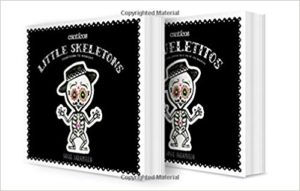By mid-August, our local grocery store had already set out jack o’ lanterns, ghosts and Happy Halloween signs. And right alongside them, Day of the Dead skeletons with bright-colored accents. By September, they had kitchenware for sale. I bought a black-and-white cup with a skull on it. I’m still eyeing the orange, magenta, and turquoise serving trays.
Welcome to Texas.
Although Day of the Dead (Día de los Muertos) and Halloween are different, the two holidays are adjacent, occurring side by side on the calendar. Day of the Dead originated in Mexico. It blends pre-Columbian celebrations by Aztec, Maya, and Toltec cultures with Catholic holidays of All Saints Day (which kicks off at sundown on All Hallow’s Eve, aka Halloween) and All Souls Day. Traditionally, children who have died are remembered on November 1 and adults on November 2. Families create ofrendas, temporary altars to honor the lives of loved ones. These are decorated with marigolds or other bright flowers. Often gravesite are also decorated. Skeletons, or calaveras, are the most common symbol of the holiday.
Day of the Dead even has its own literary tradition. The word calaveras also refers to short poems, often about someone who isn’t actually dead. Think of it as a fake epitaph, but edgier. The rhymes are usually humorous, often satirical, sometimes censored. You’re more likely to find a poem about a corrupt politician than, say, a beloved dog. The form might also be used in a newspaper, or in a classroom setting. Children’s writer Diane Gonzales Bertrand uses calaveras in her writing classes at St. Mary’s University in San Antonio to help her students write about both living and deceased people.
Right as our grocery store was gearing up for Day of the Dead, Canticos published the fifth book in its collection, Little Skeletons / Esqueletitos. It’s based on the traditional Spanish nursery rhyme “Los esqueletos salen de la tumba,” or “The skeletons leave the tomb.” (Some versions use the word Calaveras.) The song teaches children to tell time. The sing-along video of the book is already available for free on YouTube. The book was named one of School Library Journal’s “49 Fantastic New Titles” for September 2017.
“Little Skeletons / Esqueletitos helps teach kids how to tell time, while reminding them of exactly how valuable time is, that each hour should be lived, no matter how simple or how extraordinary the moment.” said Susie Jaramillo, the book’s author and illustrator and the co-founder of Canticos.
I purchased the book, subtitled Countdown to Midnight, and read it while I drank tea out of my Day of the Dead cup. Like all Canticos books, this one unfolds, accordion-style, so that the story can be read in English on one side and in Spanish on the other.
The first page features a clock with movable hands. As pages unfold, we count from 1 to 12. On the top-left corner of each page is the countdown to midnight, with the number signifying the hour placed in the center of the marigold-shaped clock and a corresponding black dot where that number is located on the clock face. Maybe if this book had been out when I was a kid, I wouldn’t have had to wait until my middle school Spanish class, when we played a version of “Around the Clock,” to learn to tell time.
The cheery skeleton on the book’s cover has accents of pink, orange, and green, but the rest of the illustrations are black and white, making us pay attention in ways we don’t when everything is rainbow bright.
There is usually something else going on in each illustration. Number 2 has different kinds of fruits. Number 6 takes place on a chess set. Characters from other Canticos titles grace the pages, all wearing Día de los Muertos masks.
When my kids were little, we did something at this time of year that was a nod to Day of the Dead. Each October we made ghosts out of Kleenex and hung them in our live oak tree — each ghost commemorating a loved one who had passed away. This year we have already attended two funerals for family members. If my kids lived here, we’d be making two more ghosts.
One difficulty that arises after someone dies is this: On which day should we remember them? The day they died? Their birthday? Those dates are meaningful to us, personally, but I like the idea behind Day of the Dead, that everyone honors those who have died together, on the same day. It makes a hard and scary thing a little less so.
“Día de Los Muertos, is both a celebration honoring those loved ones we lost, whom we would like to think still walk among us, and a reminder that life is short and precious, and we should treasure the time we have,” Jaramillo said.
_______________
To learn more, picture books (of course!)
The Day of the Dead / El Dia De Los Muertos, Bob Barner. This is one you’ll want to get on Audible so you can enjoy the guitar.
Uncle Monarch and the Day of the Dead, Judy Goldman, illus. Rene King Moreno. There is a legend that the souls of loved ones return as monarch butterflies because Día de los Muertos coincides with the annual migration of monarchs to Mexico for the winter.
Day of the Dead, . I found this one at The Book Loft in Solvang, California. Long live independent bookstores!
Funny Bones: Posada and his Day of the Dead Calaveras, Duncan Tonatiuh. If you’d like to learn more about where the holiday’s wonderful art comes from, meet artist and political cartoonist José Guadalupe Posada.
Photo by LadyDragonflyCC – >;<, Creative Commons, via Flickr. Post by Megan Willome, author of The Joy of Poetry.
- Perspective: The Two, The Only: Calvin and Hobbes - December 16, 2022
- Children’s Book Club: A Very Haunted Christmas - December 9, 2022
- By Heart: ‘The night is darkening round me’ by Emily Brontë - December 2, 2022


Bethany R. says
It is an interesting question about when to honor a loved one that’s passed away. I didn’t know much about this holiday, thank you for the educational post.
Megan Willome says
Bethany, it’s a holiday I never appreciated until after my mom passed away.